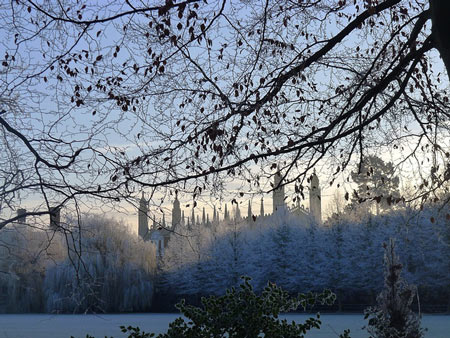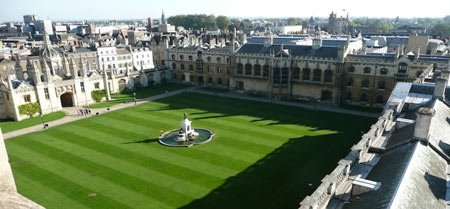The culinary oddity that is Cambridge, featuring a review of The Cambridgeshire Cook Book.
It is a culinary oddity that nearly no recipes bear a traditional association with Cambridge. Neither the city nor its storied university, let alone the county writ large, appears to have contributed much of significance to British foodways.

Glyn Lloyd-Hughes, for instance, describes over three thousand items in The Foods of England. Excluding false positives including universal commodities, extinct dishes and a formula for punch, he has found only two recipes linked to Cambridge, an eponymous pudding and a sausage, and but one (another sweet pudding) to its county. Oxford fares better: The great rival and its county tally a total of twenty-nine entries.
Excluding the same kind of outliers identified in The Foods of England , Nell Heaton has the same two recipes and nothing else in Traditional Recipes of the British Isles . She does, however, name the dessert after Newmarket, the racing town in Suffolk, and provides a characteristically unedifying description of the sausage, as “made of sausage meat in skins.” (Heaton 124) This could emanate from anywhere but in fact Cambridge did create a distinctive sausage bound with rice and laced with
“a heavy admixture of sweet spices such as mace, ginger and nutmeg…. Escoffier considered the seasoning of Cambridge Sausages to be ‘excessive’, which it should be.” (Lloyd-Hughes 119)
Other sources add various combinations of allspice, cayenne and white pepper along, sometimes, with sage. Whatever combination seasons them, Cambridge sausages are unusual and good, so unusual that they have fallen into obscurity. ( see , e.g. , “Local Food Heroes”)
The wonderful Helen Edden, whose County Recipes of Old England belongs on the bookshelf of every cook, also attributes only two recipes to Cambridgeshire, each of them a cheese. One of them is the extinct variety noted by Lloyd-Hughes and the other a generic cream cheese.
Jamie Oliver claims burnt cream, originally English but hijacked by France as crème brûlée, for Cambridge, but only because, he claims, Trinity College had been serving it since the seventeenth century. (Oliver) Trinity is, however, by no means the only or earliest English source of the recipe, and nothing connects the college with its burnt cream that long ago, so we cannot in conscience claim it for Cambridge. As Jane Grigson, a more rigorous scholar than the frantic Oliver, wrote during 1985 of the custard in British Cookery :
“A phoenix dish of our cookery, that rises again and again into popularity. It appears first in seventeenth-century, then in eighteenth century books, and then disappears to bob up at the beginning of this century at Trinity College, Cambridge.” (Grigson **)
The encyclopedic British Cookery compiled by Lizzie Boyd (“A comprehensive guide to culinary practice in the British Isles”) includes not a single Cambridge recipe per se. It lists a “Cambridge sauce,” but that is only the addition of green herbs, capers and cayenne to the standard English salad cream (both versions quite good, and now unfortunately neglected) along with a couple of drinks. As for the sauce, according to Lloyd-Hughes “there is good evidence its origin is Cambridge, Massachusetts.” (Lloyd-Hughes 194)
British Cookery unaccountably overlooks Cambridge pudding, which appears in at least two seventeenth century sources. The first, A New Booke of Cookerie by John Murrell, dates to 1615. The second, from 1672, is Hannah Wooley’s Queene-Like Closet. It is not unlikely that Woolley plagiarized Murrell: Her recipe is identical but for the addition of rosewater, although she does note that instead of boiling the pudding “[y]ou may bake it if you please in a baking-pan,” a bit of an innovation.

The Cambridge pudding is typical of the seventeenth century in employing dried fruit (currants and dates) in a rich eggy pastry shortened, of course given its time, and timelessly, with suet. It also is distinctive in sandwiching a layer of butter between discs of the pudding mixture itself, and while nowadays obscure ought not to be, for it is good.
The dearth of Cambridge cookbooks of course matches the dearth of Cambridge recipes. Richard Bradley wrote several books on cookery from his chair as professor of botany at Cambridge during the early eighteenth century. While he does attribute some recipes to specific places--Buckinghamshire, Norfolk, Shropshire, Suffolk, Worcestershire--none of his dishes owes a debt to the city of Cambridge or its environs.
In less distant times the city has produced nearly none of the little county cookbooks beloved of charitable organizations elsewhere in the British Isles during the nineteenth and twentieth centuries, not even cookbooks lacking recipes from Cambridge itself. J. Salmon includes no volume on Cambridge in its series of regional recipe booklets, while the city and shire make no contribution to the chapter on East Anglia from British Cookery by Mrs. Grigson.
Now, for all intents and purposes for the first time, a Cambridge cookbook, appropriately enough The Cambridge Cook Book , has appeared in print. In essence an advertising vehicle for the new wave of restauranteurs hoping with some success to bring good and reasonably affordable food to city and shire, the Cook Book is with noticeable exceptions a lot more than an exercise in aspirational illustration.
How much of traditional Cambridge cuisine inhabits these pages? Not much, but there is nonetheless much to like, in particular a cocktail from the Pint Shop, slow roasted recipes for beef and especially lamb, along with something like an Anglo-Italian Cuban sandwich transformed into a species of pie.
Recipes from The Cambridge Cook Book and historically from Cambridge itself appear in the practical .
Sources:
Lizzie Boyd (ed.), British Cookery: A complete guide to culinary practice in the British Isles (Woodstock, NY 1979)
Helen Edden, County Recipes of Old England (London 1929)
Jane Grigson, British Cookery (New York 1985)
Nell Heaton, Traditional Recipes of the British Isles (London 1951)
www.localfoodheroes.co.uk/?e=765 (accessed 22 October 2015)
Glyn Lloyd-Hughes, The Foods of England (Adlington, Lancs 2010)
www.jamieoliver.com/magazine/recipes-view.php?title=cambridge-burnt-cream (accessed 13 October 2015)
Lisa Pullen (ed.), The Cambridge Cook Book (Sheffield 2015)

